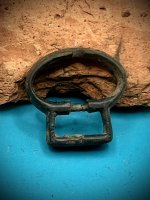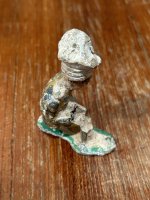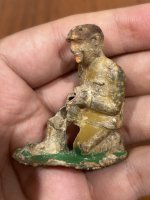Tallone
Hero Member
My wife grew up in the Panama Canal Zone. She has a fairly large collection of molas that she purchased in the 1960s and 70s. She is a 3rd generation "Zonian" (that's what they call themselves). Her grandfather came to Panama from Ireland during construction of the canal. Of course, there is no Canal Zone anymore having been handed over to Panama without compensation by President Carter in the 1970s - still a sore spot for most Zonians. But I digress... Canal Zone history is relevant to this discussion, however. I will get to that in a moment.
Diggummup's thread on African masks and the question of whether or not they are old made me think of my wife's molas. We sold of few of her molas on ebay a couple of years ago and they brought decent prices ($30 - $50 each). I just checked the sold listings on ebay and it seems to me prices for molas are going up.
You can look up details on molas on the web but the basics facts are these: Molas are textile art made by the Kuna tribe of the San Blas islands in Panama. Molas are an applique technique and were usually made by Kuna women and often used as part of their clothing - usually the front and back panels of a blouse. Below is an example from our collection:
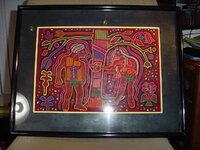
This mola has been framed because, in my opinion, it is the best, and most intricate, mola I have ever seen. I purchased this one for $50 during my first visit to Panama with my wife in 1983. I purchased it from the Kuna woman who made it. It had originally been part of a blouse. The other panel was also an Adam & Eve scene but it was not as intricate as this one. I didn't want to spend that much money to buy both and I had a hard time talking the woman into selling just this one as she wanted to sell them as a pair. I should have bought the other too. Oh well.... Anyway, I am showing you guys this to point out details to look for if you ever come across molas.
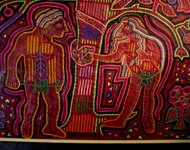
The picture above shows the mola in a little more detail. Notice the intricacy of the design. Lots of visual elements. Lots of molas, especially the recently produced tourist junk, are very simple in design. Like all art, of course, beauty is in the eye of the beholder and that will matter to buyers but what I mainly want to focus on is the quality of the workmanship.
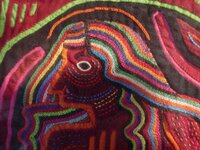
The hair is what initially attracted me to this particular mola. I have never seen anything like it. Imagine the time and skill it took to produce those hundreds of stitches. Notice the tightness and consistency of the stitching. But the two pictures below are better examples of what to look for as they illustrate the kind of things you will see in every mola.
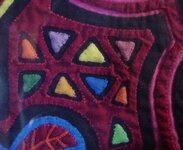
In the photos above and below, I want to point out two things. One is the stitching. Notice how consistent the spacing is between stitches. In the cheap tourist pieces, the stitches are usually loose and uneven. These stitches are pulled snug and the distance between them is almost the same everywhere on the piece. The stitches almost disappear.
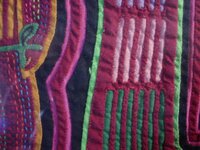
Molas are made from layers of fabric with cutouts made in some pieces to show the different colored fabric underneath and sometimes small pieces cut to stitch on top of other pieces. In hastily produced pieces, the width of the cutouts and borders will vary significantly. In a high quality piece these will be very even throughout.
Now to the part about Canal Zone history and how that ties in to molas. With the dissolution of the Canal Zone, almost all Americans were phased out of canal operations and repatriated to the U.S. Many of them settled in Florida but there are Zonians in many parts of the country. I know there are quite a few in Texas, Georgia, and California. Many Zonians (like my wife) bought lots of molas and most of them were purchased in the 1970s or earlier before the American families started leaving the Zone. I have made several trips to Panama over the past 30 years with the most recent trip being in 2010. My first trip was in 1983 and the Kunas had not yet begun to produce molas in large quantities. You didn't have to travel to the San Blas islands to get them in 1983 but there were only a few locations where the Kunas were selling them on the mainland. In 2010, it seemed like molas were everywhere. I looked at a lot of molas on that trip and they were all poorly made.
Anyway, the Zonians are a dying breed and their estates are coming on the market. You are most likely to encounter them in Florida. Good quality molas are bringing nice prices these days. And Canal Zone stuff in general is collectible and also brings pretty good prices. My wife and I have a mini Canal Zone museum (see photo below) and I'm always looking for new pieces.
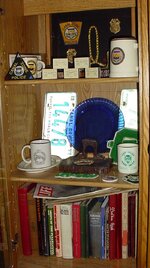
Good luck out there!
Diggummup's thread on African masks and the question of whether or not they are old made me think of my wife's molas. We sold of few of her molas on ebay a couple of years ago and they brought decent prices ($30 - $50 each). I just checked the sold listings on ebay and it seems to me prices for molas are going up.
You can look up details on molas on the web but the basics facts are these: Molas are textile art made by the Kuna tribe of the San Blas islands in Panama. Molas are an applique technique and were usually made by Kuna women and often used as part of their clothing - usually the front and back panels of a blouse. Below is an example from our collection:

This mola has been framed because, in my opinion, it is the best, and most intricate, mola I have ever seen. I purchased this one for $50 during my first visit to Panama with my wife in 1983. I purchased it from the Kuna woman who made it. It had originally been part of a blouse. The other panel was also an Adam & Eve scene but it was not as intricate as this one. I didn't want to spend that much money to buy both and I had a hard time talking the woman into selling just this one as she wanted to sell them as a pair. I should have bought the other too. Oh well.... Anyway, I am showing you guys this to point out details to look for if you ever come across molas.

The picture above shows the mola in a little more detail. Notice the intricacy of the design. Lots of visual elements. Lots of molas, especially the recently produced tourist junk, are very simple in design. Like all art, of course, beauty is in the eye of the beholder and that will matter to buyers but what I mainly want to focus on is the quality of the workmanship.

The hair is what initially attracted me to this particular mola. I have never seen anything like it. Imagine the time and skill it took to produce those hundreds of stitches. Notice the tightness and consistency of the stitching. But the two pictures below are better examples of what to look for as they illustrate the kind of things you will see in every mola.

In the photos above and below, I want to point out two things. One is the stitching. Notice how consistent the spacing is between stitches. In the cheap tourist pieces, the stitches are usually loose and uneven. These stitches are pulled snug and the distance between them is almost the same everywhere on the piece. The stitches almost disappear.

Molas are made from layers of fabric with cutouts made in some pieces to show the different colored fabric underneath and sometimes small pieces cut to stitch on top of other pieces. In hastily produced pieces, the width of the cutouts and borders will vary significantly. In a high quality piece these will be very even throughout.
Now to the part about Canal Zone history and how that ties in to molas. With the dissolution of the Canal Zone, almost all Americans were phased out of canal operations and repatriated to the U.S. Many of them settled in Florida but there are Zonians in many parts of the country. I know there are quite a few in Texas, Georgia, and California. Many Zonians (like my wife) bought lots of molas and most of them were purchased in the 1970s or earlier before the American families started leaving the Zone. I have made several trips to Panama over the past 30 years with the most recent trip being in 2010. My first trip was in 1983 and the Kunas had not yet begun to produce molas in large quantities. You didn't have to travel to the San Blas islands to get them in 1983 but there were only a few locations where the Kunas were selling them on the mainland. In 2010, it seemed like molas were everywhere. I looked at a lot of molas on that trip and they were all poorly made.
Anyway, the Zonians are a dying breed and their estates are coming on the market. You are most likely to encounter them in Florida. Good quality molas are bringing nice prices these days. And Canal Zone stuff in general is collectible and also brings pretty good prices. My wife and I have a mini Canal Zone museum (see photo below) and I'm always looking for new pieces.

Good luck out there!




